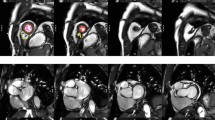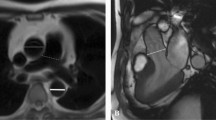Abstract
To determine the evolution of the diameter of the thoracic aorta with age in order to detect dilatation more reliably by imaging, we performed a retrospective analysis of the MRI examinations of the normal thoracic aorta of 66 subjects aged 44.1±19.1 years (range 19.1–82.4 years) obtained between 1991 and 2000 on a Magnetom SP 42 1T apparatus (Siemens) using T1-weighted spin echo sequences with electrocardiographic synchronization. Sixteen measurements were made in the axial plane, the oblique sagittal plane in the axis of the aortic arch, and the oblique frontal plane perpendicular to the latter at the level of the ascending aorta, the arch and the descending thoracic aorta. We found an increase in the thoracic aorta diameter and a significant relationship between this diameter and the age of our subjects, wherever the measure was performed. However, there was no systematic correlation between aortic diameter and age. The aortic diameter evolved with age and a marked difference seemed to exist in measurements made in groups younger and older than 40 years. This study, conducted on a small population of 66 patients, thus helps to define a normal aortic diameter, thereby making the diagnosis of pathological dilatation of the aorta more reliable.
Résumé
Pour déterminer l'évolution du diamètre de l'aorte thoracique en fonction de l'âge afin de pouvoir juger d'une éventuelle dilatation sur les examens d'imagerie, les auteurs ont analysé rétrospectivement des Imageries par Résonance Magnétique d'aortes thoraciques normales de 66 sujets âgés de 44,1±19,1 ans (19,1 à 82,4 ans) réalisés de 1991 à 2000 sur un appareillage Magnetom SP 42 de 1 T (Siemens, Erlangen) en séquences de spin écho pondérées en T1 avec synchronisation à l'électrocardiogramme; 16 mesures étaient effectuées dans les plans transversal, sagittal oblique dans l'axe de l'arc de l'aorte, et frontal oblique perpendiculaire au précédent au niveau de l'aorte ascendante, l'arc de l'aorte et l'aorte thoracique descendante. Il existait un accroissement significatif du diamètre de l'aorte sur les mesures effectuées en fonction de l'âge. En revanche il n'existait pas de corrélation systématique entre diamètre aortique et âge. Le diamètre aortique évoluait en fonction de l'âge de manière significative avec une différence qui paraissait nette entre la cohorte des sujets de moins de 40 ans celle des patients de plus de 40 ans. Cette étude, effectuée sur une courte série de 66 patients, permet donc d'approcher le diamètre aortique normal et d'aider au diagnostic de dilatation pathologique de l'aorte.



Similar content being viewed by others
References
Achiron R, Zimand S, Hegesh J, et al (2000) Fetal aortic arch measurements between 14 and 38 weeks' gestation: in utero ultrasonographic study. Ultrasound Obstet Gynecol 15: 226–230
Al-Ali F, Higgins CB, Gooding CA (1994) MRI of tracheal and esophageal compression following surgery for congenital heart disease. J Comput Assist Tomogr 18: 39–42
Althaus U, Marincek B (1984) [Thoracic aortic aneurysms]. Schweiz Med Wochenschr 114: 1547–1559
Amemiya H, Okubo S, Hongo M, et al (1983) Usefulness of dynamic computed tomography in the diagnosis of thoracic aortic aneurysms. J Cardiogr 13: 103–116
Angelini A, Allan LD, Anderson RH, et al (1988) Measurements of the dimensions of the aortic and pulmonary pathways in the human fetus: a correlative echocardiographic and morphometric study. Br Heart J 60: 221–226
Aronberg DJ, Glazer HS, Madsen K, et al (1984) Normal thoracic aortic diameters by computed tomography. J Comput Assist Tomogr 8: 247–250
Bailey YD, Cooper SG, Schur I, et al (1996) Can helical CT replace aortography in blunt aortic trauma? Radiology 201: 579–580
Beekman RP, Beek FJ, Meijboom EJ (1997) Usefulness of MRI for the pre-operative evaluation of the pulmonary arteries in tetralogy of Fallot. Magnet Reson Imaging 15: 1005–1015
Beitzke A, Stein JI, Gamillscheg A, et al (1997) Dissection of the descending aorta after balloon angioplasty of native coarctation. Pediatr Cardiol 18: 222–225
Biswas PK, Mitra K, De S, et al (1996) Follow-up results of balloon angioplasty for native coarctation of aorta. Indian Heart J 48: 673–676
Bloom AI, Sasson T, Rivkind A, et al (1995) Diagnosis of traumatic rupture of the thoracic aorta using dynamic rapid sequence axial computerized tomography. Isr J Med Sci 31: 314–320
Bromberg BI, Beekman RH, Rocchini AP, et al (1989) Aortic aneurysm after patch aortoplasty repair of coarctation: a prospective analysis of prevalence, screening tests and risks. J Am Coll Cardiol 14: 734–741
Brouwer MH, Cromme-Dijkhuis AH, Ebels T, et al (1992) Growth of the hypoplastic aortic arch after simple coarctation resection and end-to-end anastomosis. J Thorac Cardiovasc Surg 104: 426–433
Caspi J, Ilbawi MN, Muster A, et al (1994) Management of hypoplastic aortic arch associated with neonatal coarctation. J Cardiovasc Surg (Torino) 35: 129–132
Cassottana P, Badano L, Piazza R, et al (1997) [Dimensions of the proximal thoracic aorta from childhood to adult age: reference values for two-dimensional echocardiography. Ligurian Group of SIEC (Italian Society of Echocardiography)]. G Ital Cardiol 27: 686–696
Choe YH, Kim YM, Han BK, et al (1997) MR imaging in the morphologic diagnosis of congenital heart disease. Radiographics 17: 403–422
Chung T (2000) Assessment of cardiovascular anatomy in patients with congenital heart disease by magnetic resonance imaging. Pediatr Cardiol 21: 18–26
Clarkson PM, Brandt PW (1985) Aortic diameters in infants and young children: normative angiographic data. Pediatr Cardiol 6: 3-6
Dawer S.P, Featherstone T, Ratcliffe MA, et al (1988) Accelerated increase in aortic diameter in patients treated for lymphoma. Heart Vessels 4: 237–240
Dinsmore RE, Liberthson RR, Wismer GL, et al (1986) Magnetic resonance imaging of thoracic aortic aneurysms: comparison with other imaging methods. AJR Am J Roentgenol 146: 309–314
Farmer DW, Lipton MJ, Webb WR, et al (1984) Computed tomography in congenital heart disease. J Comput Assist Tomogr 8: 677–687
Fitzgerald SW, Donaldson JS, Poznanski AK (1987) Pediatric thoracic aorta: normal measurements determined with CT. Radiology 165: 667–669
Frija J, Larde D, Katz M, et al (1982) Computed tomography diagnosis of anomalies of the aortic arch in the adult. J Radiol 63: 159–165
Heiberg E, Wolverson MK, Sundaram M, et al (1983) CT in aortic trauma. AJR Am J Roentgenol 140: 1119–1124
Helbing WA, De Roos A (2000) Clinical applications of cardiac magnetic resonance imaging after repair of tetralogy of Fallot. Pediatr Cardiol 21: 70–79
Higgins CB, Byrd BF, Farmer DW, et al (1984) Magnetic resonance imaging in patients with congenital heart disease. Circulation 70: 851–860
Kato M, Bai H, Sato K, et al (1995) Determining surgical indications for acute type B dissection based on enlargement of aortic diameter during the chronic phase. Circulation 92 [Suppl]: 107–112
Kersting-Sommerhoff BA, Sechtem UP, Schiller NB, et al (1987) MR imaging of the thoracic aorta in Marfan patients. J Comput Assist Tomogr 11: 633–639
Lemon DK, White CW (1978) Anuloaortic ectasia: angiographic, hemodynamic and clinical comparison with aortic valve insufficiency. Am J Cardiol 41: 482–486
Lorenz CH (2000) The range of normal values of cardiovascular structures in infants, children, and adolescents measured by magnetic resonance imaging. Pediatr Cardiol 21: 37–46
Moreno M, Moore J Jr, Meuli R (1998) Cross-sectional deformation of the aorta as measured with magnetic resonance imaging. J Biomech Eng 120: 18–21
Rammos S, Kramer HH, Trampisch HJ, et al (1989) Normal values of the growth of the aorta in children. An angiography study. Herz 14: 358–366
Rodenwaldt J, Kopka L, Vosshenrich R, et al (2000) 3D MR angiography of the entire aorta: modified application of the body-phased array coil for a single-shot technique. Eur J Radiol 33: 41–49
Schmidt M, Theissen P, Deutsch HJ, et al (2000) Congenitally corrected transposition of the great arteries (L-TGA) with situs inversus totalis in adulthood: findings with magnetic resonance imaging. Magnet Reson Imaging 18: 417–422
Shimada I, Rooney SJ, Farneti PA, et al (1999) Reproducibility of thoracic aortic diameter measurement using computed tomographic scans. Eur J Cardiothorac Surg 16: 59–62
Sievers HH, Onnasch DG, Lange PE, et al (1983) Dimensions of the great arteries, semilunar valve roots, and right ventricular outflow tract during growth: normative angiocardiographic data. Pediatr Cardiol 4: 189–196
Stefanadis C, Stratos C, Vlachopoulos C, et al (1995) Pressure-diameter relation of the human aorta. A new method of determination by the application of a special ultrasonic dimension catheter. Circulation 92: 2210–2219
Toda T, Tsuda N, Nishimori I, et al (1980) Morphometrical analysis of the aging process in human arteries and aorta. Acta Anat (Basel) 106: 35–44
Towfiq BA, Weir J, Rawles JM (1986) Effect of age and blood pressure on aortic size and stroke distance. Br Heart J 55: 560–568
Author information
Authors and Affiliations
Corresponding author
Rights and permissions
About this article
Cite this article
Garcier, JM., Petitcolin, V., Filaire, M. et al. Normal diameter of the thoracic aorta in adults: a magnetic resonance imaging study. Surg Radiol Anat 25, 322–329 (2003). https://doi.org/10.1007/s00276-003-0140-z
Received:
Accepted:
Published:
Issue Date:
DOI: https://doi.org/10.1007/s00276-003-0140-z




